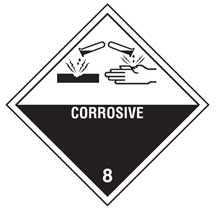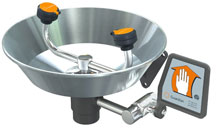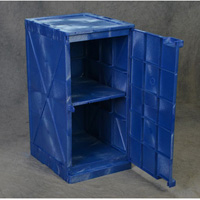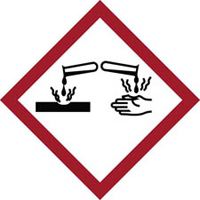



Find all of your laboratory and workplace safety supplies at Safety Emporium!
 ACGIH |
 Glossary Index |
 Acidosis |
| MSDS Topics |
Free Sites | FAQ's | Regulations | Glossary | Software | Suppliers |
| Books | Forum | Poll | Fun stuff | Quiz | Store | |
| Understand your MSDS with the MS-Demystifier | Search ALL our MSDS info | |||||

Be sure you're in compliance with DOT placards and labels from Safety Emporium.
There are several definitions for acid:
There are several other definitions that go beyond the scope of this article; see Further Reading for more information. For the remainder of this article we will focus on acids in aqueous solution as that's how most of our readers will encounter them.
An acidic solution is defined as one that has a pH less than 7.0.
Strong acids completely dissociate (separate) into ions (negatively charged anions and positively charged cations) to form H+ in aqueous (water) solution.
"H" is the elemental symbol for the element hydrogen. A single hydrogen atom consists of a positively-charged proton and a negatively-charged electron, so H+ indicates a hydrogen atom that has lost its electron and consists only of proton. Therefore, chemists refer to H+ as a hydrogen ion and they also call it a proton.
For example, when HCl (hydrogen chloride gas) is bubbled into water, the individual molecules of HCl break up in hydrogen cations and chloride anions. We can express this behavior with the reaction equation shown below, where the single-headed arrow signifies that the reaction proceeds completely to the right (e.g. there will be no discrete HCl molecules left in the solution) and the "(aq)" indicates that the ions are dissolved in the water:
HCl → H+(aq) + Cl-(aq)
Chemists will tell you that the following equation is more correct because H+ ions actually exist as H3O+ ions (called hydronium cations) in water:
HCl + H2O → H3O+(aq) + Cl-(aq)
The actual behavior in water is far more complex, but either of the above are a convenient enough way of thinking about how acids dissociate in water.
Regardless of how you write the equations, all of the following strong acids will cause severe and immediate burns upon skin contact:
| Formula | Name |
| HClO4 | Perchloric acid |
| HI | Hydroiodic acid |
| HBr | Hydrobromic acid |
| HCl | Hydrochloric acid |
| H2SO4 | Sulfuric acid |
| HNO3 | Nitric acid |
The acids listed above are all examples of inorganic acids, sometimes called mineral acids. Mineral/inorganic acids can be strong or weak.

OSHA requires eyewashes and safety showers in workplaces where corrosive materials are used. Get yours from Safety Emporium.
Weak acids do not dissociate completely in solution - there is always some of the undissociated material remaining. Examples of these include acetic acid (a 5% solution of acetic acid in water is called vinegar), formic acid, ammonium cation (NH4+), and water itself. In these cases, the incomplete dissociation is indicated with a reversible equilibrium arrow as shown here for the dissolution of ammonium cation in water to produce ammonia and a hydronium ion:
H2O + NH4+ ⇋ NH3 + H3O+
The "equilibrium arrows" between the starting material (reactant) and products indicate that the reaction proceeds in both the forward and backwards directions simultaneously with all species co-existing in solution simultaneously. The relative amounts of products and reactants once the system reaches equilibrium vary from reaction to reaction and are expressed using an equilibrium constant, a topic that is beyond the scope of this text.

Organic substances with names that end in "oic acid" or "ic acid" are called carboxylic acids. Two of the examples we just mentioned, formic acid and acetic acid, are carboxylic acids. All carboxylic acids are weak acids.
The strength of acidic solutions can be measured using the pH scale. The lower the pH, the greater the acidity of a solution.
Just because an acid is weak does not mean that it can't harm you. For example, HF, hydrofluoric acid, is a weak inorganic acid. When you spill it on your hand it doesn't burn...but over the course of hours it migrates to the bones in your fingers and then begins to dissolve them from the inside out (a painful process; amputation can be required). In addition, systemic effects such as hypocalcemia can cause death. See the HF links under Further Reading below for more information.
Some common properties of acids are:
The concentration of acids can be expressed in many different ways:

Get your corrosion-resistant polyethylene acid storage cabinets with internal sumps from Safety Emporium.
It is important to know the pH of substances because they may be corrosive or react with incompatible materials. For example acids and bases should not be stored or used near each other as their accidental combination could generate a huge amount of heat and energy, possibly resulting in an explosion - here is a terrific example of what can happen when incompatibles are mixed!
If the substance you're working with is a liquid, the pH (if known) will be found in Section 9 (physical and chemical properties) of the Safety Data Sheet. You will also find all sorts of safety precautions, incompatibility information, physical properties, emergency information and more elsewhere on the SDS so be sure to read the sheet in its entirety.
pH is also important to know in case you spill the material on your skin or eyes. Whenever a substance enters the eye, flush with water for 15 minutes and get prompt medical attention.
Special care needs to be taken when storing acids. Minor spills and acid fumes can quickly corrode standard metal storage cabinets or soapstone countertops, for example. The best choice for storing acid containers is a chemically-resistant cabinet designed for that purpose, with polyethylene construction being the best choice for laboratory quantities of acids. Polyethylene spill trays are also a very good idea, whether acids are stored on a bench top or in a cabinet.

Get your GHS-compliant labels and signs from Safety Emporium.
See also: anyhdride, base, carbon dioxide, corrosive, pH